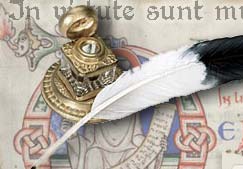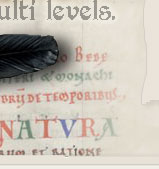znaleziono gdzieś w necieDesign Note:
Lead Screw Thread Pitch Selection
In the United States civil engineers and woodworkers most often specify measurements in binary fractions of an inch (1/2, 1/4, .., etc.) Mechanical engineers most often specify measurement in decimal fractions of an inch. Most of the remainder of the world uses the SI system of measurement, specifying decimal fractions of a millimeter.
Software drivers such as TurboCNC will round positioning to the precision of the machine. To achieve desired positioning precision the hardware components of the CNC machine must be chosen with care.
This design note details lead screw thread pitch selection to optimize the precision of a CNC machine for a particular system of measurement. It assumes aboslute accuracy. Accuracy is discussed in another design note.
It is important to understand the following terms before continuing:
precision - degree of refinement of measurement
resolution - an instrument's ability to distinguish very small or very close objects. This is generally the same as precision
accuracy - degree of conformity to a standard
Take a common stepper motor as an example. The Eastern Air Devices(EAD) LA23ECK series has:
Precision: 1.8 degrees or 1/200th of a revolution
Resolution: same as precision
Accuracy: +/- 3% or +/- 0.054 degrees
EAD also specifies that positional accuracy is non-cumulative. This means that a rotation of 10 steps will yield an angle offset from the starting position by 18 degrees +/- 0.108 degrees. (The positional accuracy of the start point plus the positional accuracy of the end point) Rotating through 200 steps will return the rotor to the exact start point.
The linear motion of any axis driven by a stepper motor / lead screw combination is given by the following formula:
|<=== stepper motor ==>|<== lead screw ==>|
step size in degrees
---------------------- X thread pitch
360 degrees
Thread pitch must be given in unit distance per thread, not threads per unit of distance. A lead screw with 20 threads per inch therefore has a pitch of 0.05 inches.
The following table gives the step travel for lead screws with various common threads in decimal inches, 64ths of an inch, and millimeters(mm) when driven by a 1.8 degree per step stepper motor.
American Standard:
=== Steps per Unit Travel ===
Threads 0.001 64ths of
per inch Pitch inches an inch mm
32 0.03125 6.4 100 251.9689*
24 0.041666667* 4.8 75 188.9767*
20 0.05 4 62.5 157.4805*
18 0.055555556* 3.6 56.25 141.7325*
16 0.0625 3.2 50 125.9844*
13 0.076923077* 2.6 40.625 102.3623*
10 0.1 2 31.25 78.7403*
8 0.125 1.6 25 62.9922*
Metric:
=== Steps per Unit Travel ===
Threads 0.001 64ths of
per inch Pitch inches an inch mm
42.3* 0.6 mm 8.4666* 132.29* 333.33*
31.7* 0.8 mm 6.3500* 99.21* 250
25.4* 1.0 mm 5.0800* 79.37* 200
16.9* 1.5 mm 3.3867* 52.92* 133.33*
12.7* 2.0 mm 2.5400* 39.69* 100
10.2* 2.5 mm 2.0320* 31.75* 80
Notes: Constant of 25.399956* used to convert inches to mm.
Values marked with an asterisk are approximations.
Achievement of a pre-determined precision with the given stepper motor is dependent upon the selection of a lead screw requiring an integer number of steps to achieve the required movement. Lead screws with 32, 24, 16, or 8 TPI are suitable in achieving a precision of 1/64 of an inch. Lead screws with 10 or 20 TPI are suitable for a precision of 0.001 inches. Lead screws with a pitch of 0.8, 1.0, 2.0, or 2.5 mm are suitable for applications requiring a precision of 0.1 mm. Precision of 0.01 mm requires lead screws with a pitch of 1.0 or 2.0 mm.
It is interesting to note that the use of a 5:1 gear ratio at the stepper motor will allow lead screws with any of the given TPI's to achieve a precision of 0.001 inches. An 8:1 gear ratio is required to use any of these lead screws for a precision of 1/64th of an inch. A gear ratio of 40:1 allows a lead screw with any of the TPI's given to achieve precisions of either 1/64 or 0.001 inches.
No American Standard threaded lead screw can be used to achieve Metric precision, and no Metric lead screw can be used to achieve American Standard precision.
Note that this design note details precision NOT accuracy. It is possible with enough flex and slop to design a system with 0.0001 inch precision and 1 yard accuracy!




